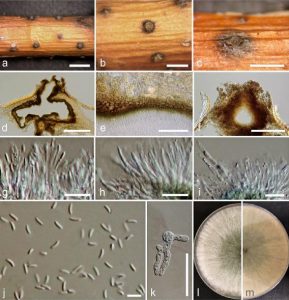Cytospora melnikii Norphanphoun, Bulgakov, T.C. Wen & K.D. Hyde, sp. nov., Index Fungorum number: IF552606
Etymology: The species named after the famous Russian mycologist Vadim Alexandrovich Melnik, researcher of anamorphic fungi.
Holotype: MFLU 15-1910
Associated with twigs and branches of Malus domestica Borkh. and Populus nigra L. var. italica Münchh. Sexual morph: Undetermined. Asexual morph: Conidiomata 470–520 × 370–420 μm diameter, semi-immersed in host tissue, solitary, scattered, erumpent, discoid, circular to ovoid, unilocular, with long ostiolar neck. Ostioles 200–230 μm long at the same level as the disc surface. Peridium comprising several layers of cells of textura angularis, with inner most layer thick, dark brown, outer layer dark brown to black. Conidiophores unbranched or occasionally branched at the base, reduced to conidiogenous cells. Conidiogenous cells blastic, enteroblastic, phialidic, formed from the inner most layer of pycnidial wall, hyaline, smooth-walled. Conidia (3.1–)4.5–5 ×1–1.2(–1.3) μm (x̅ = 4.6 × 1.2 μm, n = 30), unicellular, allantoid to subcylindrical, hyaline, smooth-walled.
Culture characteristics: Colonies on MEA, reaching the edge of the Petri-dish after 6–7 days at 25 °C, producing dense mycelium, circular, margin rough, white, with aerial mycelium.
Material examined: RUSSIA, Rostov Region, Oktyabrsky District, south edge of Persianovsky settlement, Khoruli gully, field-protecting shelterbelt, on dying branches of Malus domestica (Rosaceae), 28 April 2015, T. Bulgakov, T-206 (MFLU 15-1910, holotype, KUN, isotype), ex-type living culture, MFLUCC 15-0851, KUMCC; RUSSIA, Rostov Region, Krasnosulinsky District, Donskoye forestry, lining-out nursery, trees and shrubs, on dying twigs and branches of Populus nigra L. var. italica (Salicaceae), 27 October 2015, T. Bulgakov, T-1104 (MFLU 15-3766, KUN), living culture, MFLUCC 16-0635, KUMCC.
Notes: Cytospora melnikii was found on Malus domestica and Populus nigra, and has semi-immersed, unilocular conidiomata, with long ostioles and shares common walls with the host tissue. Cytospora melnikii can be distinguished based on the characteristics of fruiting bodies, conidia size, cultural characteristics and phylogenetic analyses. Cytospora melnikii is most similar to C. chrysosperma, which was found Malus. However, C. chrysosperma differs in having a multiloculate conidiomata (Mehrabi et al. 2011).
In phylogenetic analyses, using ITS sequence data, C. melnikii groups with C. chrysosperma (HMBF151, HMBF158, HMBF17) and C. salicacearum (MFLUCC 16-0509, MFLUCC 16-0587, MFLUCC 15-0861, MFLUCC 16-0576). The tree using ITS, LSU, RPB2 and ACT sequence data demonstrate that C. melnikii is clearly separated from these taxa, with moderate bootstrap support. Thus, based on phylogenetic analysis and morphological differences, it is considered that C. melnikii is a novel species.
FIG: Cytospora melnikii on Malus domestica (MFLU 15-1910, holotype). a Stromatal habit in wood. b Fruiting bodies on substrate. c Surface of fruiting bodies. d Cross section of the stroma showing conidiomata. e Peridium. f Ostiolar neck. g–i Conidiogenous cells with attached conidia. j Conidia. k Germinating spore. l, m Colonies on MEA with 7 days (l-from above, m-from below). Scale bars: a =2000 μm, b = 500 μm, c = 500 μm, d = 200 μm, e = 30 μm, f = 100 μm, g, h, i, j = 10 μm.

